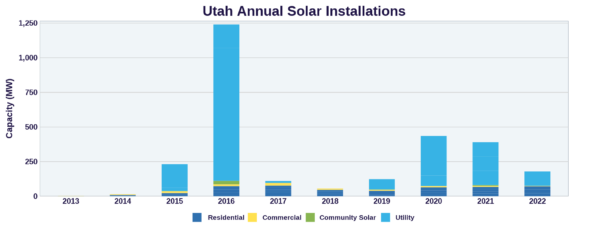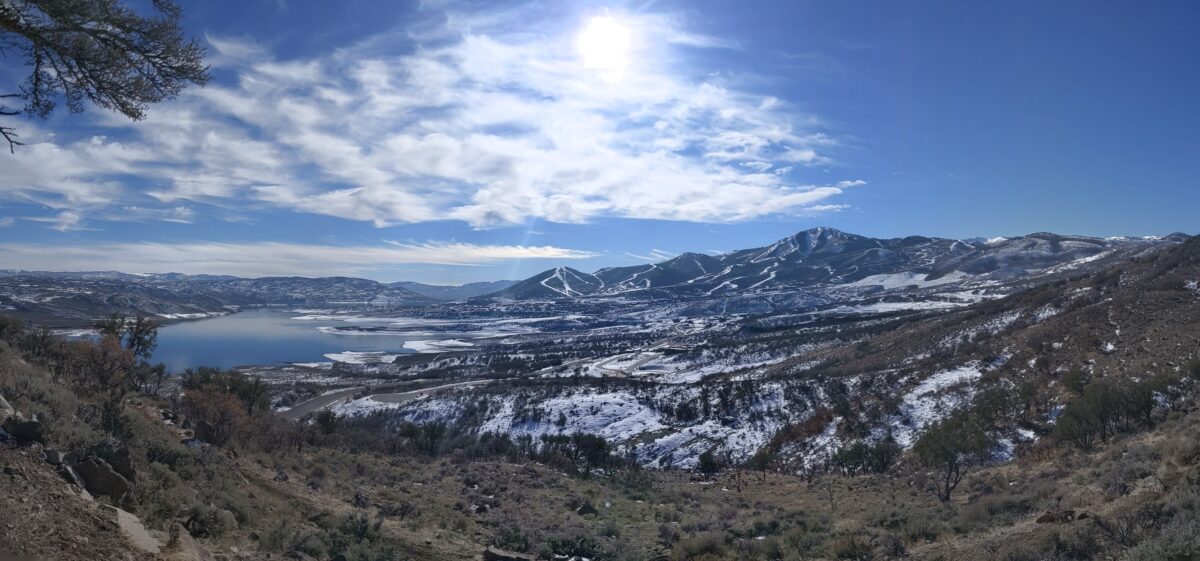The state of Utah enjoys an unusual combination of land types, from the Rocky Mountains to the Great Basin to the Colorado plateau. It’s known for the Great Salt Lake, the dramatic scenery in Arches and Canyonlands National Parks and outstanding year ‘round recreation throughout the state. While it is not known as a state with strong support for solar and other renewable energy, its wide open spaces are amenable to utility-scale solar and it ranks 12th in the country for solar installed, which is up from 22nd place in early 2022, according to the Solar Energy Industries Association (SEIA).
Electricity in Utah is relatively inexpensive, at 8.34 cents per kWh, according to the Energy Information Administration. The 2.7 GW of solar installed is enough to power 504,102 homes, according to SEIA, and it provides just over 11.5% of the state’s electricity.

Rocky Mountain Power is the state’s largest utility. It is owned by PacifiCorp, which announced its 2023 integrated resource plan that sets all of its utilities on a path to net zero. It calls for a nearly four-fold increase in the utility’s current wind and solar resources, to a total of 20 GW by 2032, in addition to 7 GW of energy storage deployments by 2029. The utility is the offtaker for the Escalante solar project (see below), currently the largest project in the Beehive State.
Solar incentives
In 2020, Utah announced an incentive of $1,600 for residential customers to go solar, but that rate drops by $400 per year, beginning in 2021, according to DSIRE.
Despite Rocky Mountain Power aiming to achieve net-zero emissions by 2032, it is not overly generous in net metering rates for energy exported to the grid. From June through September 2023, it pays 5.636 cents per kWh for all exported kWh; and from October through May 2024 it drops to 4.745 cents per kWh for all exported kWh.
Net metering is offered by other Utah utilities, such as Murray City Power, which started a pilot program for renewable installation of up to 10 kW. The way Murray’s net metering framework works is that the electric customer receives credit on their next bill for all electric energy that they’ve fed into the grid in excess of what the city supplied during that billing period. Then in April, if the customer has a credit, it’s applied toward any electricity used in subsequent months. No cash is offered for excess generation.
Solar rights
Under the state’s solar rights law, which was enacted in 2017, homeowner associations cannot prohibit or restrict owners of detached dwellings from installing solar. It does not apply, however, in dwellings where the ownership has an interest in the rooftop. An association may have a declaration that prohibits solar or limits size, location and placement on owners with detached dwellings. Association rules may also require solar energy systems to meet health, safety and building performance standards, and they may limit roof overlap, color or texture, and may exclude visible piping or wiring. For ground-mounted systems, associations may require that systems not be visible from the street.
The state law also states that local zoning boards may adopt regulations that mandate solar access and grants the zoning body the right to refuse a plan if deed restrictions, covenants or other agreements running with the land prohibit “reasonably sited and designed solar collectors or other renewable resource devices”. The state includes clotheslines in the definition of renewable resource devices.
Landmark installations
The 240 MW Escalante Solar Project is three separate solar installations, located in the town of Milford in Beaver County. Developed by SunEdison and built by Mortenson Construction, the projects came online in 2016, and the power is sold under three power purchase agreements to Rocky Mountain Power. Taken together, it is the largest solar plant in the state.
The 180 MW Cove Mountain solar projects in Iron Beryl, Utah, are the next largest. Completed in 2021 by D.E. Shaw Renewables, Meta (formerly Facebook) is the offtaker of electricity from both Cove Mountain (58 MW) and Cove Mountain II (122 MW). The two projects were part of a flurry of PPAs that Facebook signed last fall to run data centers on clean, renewable energy.
More large-scale solar is likely on the way for Utah, as the Federal Energy Act of 2020 aims to deploy 25 GW of solar, wind, and geothermal production on public lands no later than 2025. One of the first land areas that was vetted for this development is in Utah, where the U.S. Department of the Interior’s Bureau of Land Management (BLM) offered 4,836 acres in Beaver County, Utah, to be bid on by solar developers.
The last stop on the pv magazine usa tour of state solar incentives was Nevada and the next will be Colorado. To see the full list to date, click here.
This content is protected by copyright and may not be reused. If you want to cooperate with us and would like to reuse some of our content, please contact: editors@pv-magazine.com.









By submitting this form you agree to pv magazine using your data for the purposes of publishing your comment.
Your personal data will only be disclosed or otherwise transmitted to third parties for the purposes of spam filtering or if this is necessary for technical maintenance of the website. Any other transfer to third parties will not take place unless this is justified on the basis of applicable data protection regulations or if pv magazine is legally obliged to do so.
You may revoke this consent at any time with effect for the future, in which case your personal data will be deleted immediately. Otherwise, your data will be deleted if pv magazine has processed your request or the purpose of data storage is fulfilled.
Further information on data privacy can be found in our Data Protection Policy.